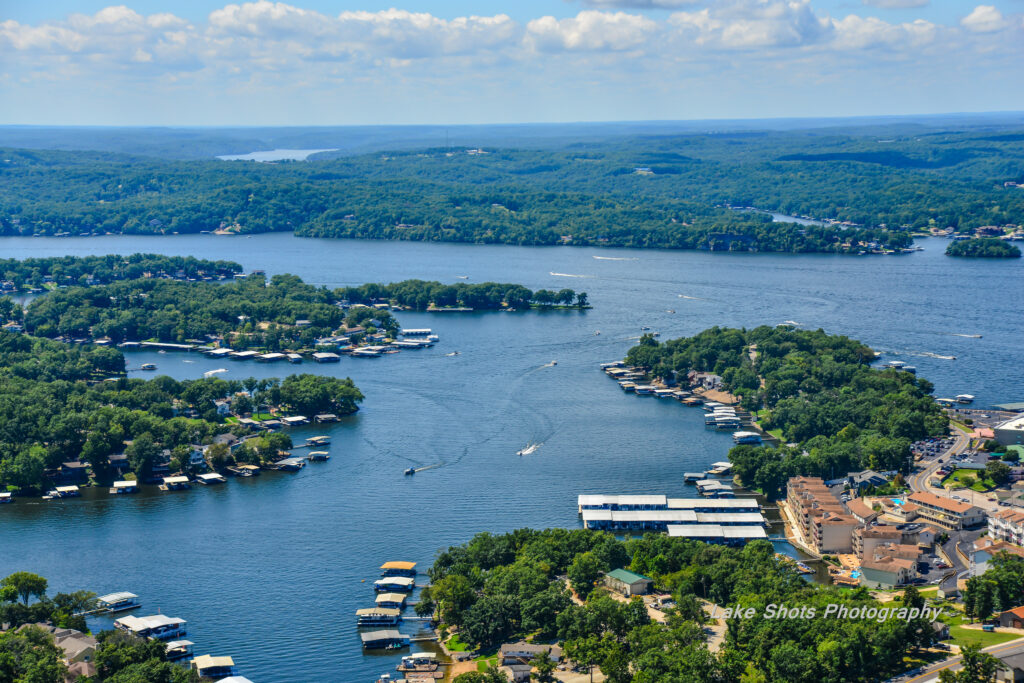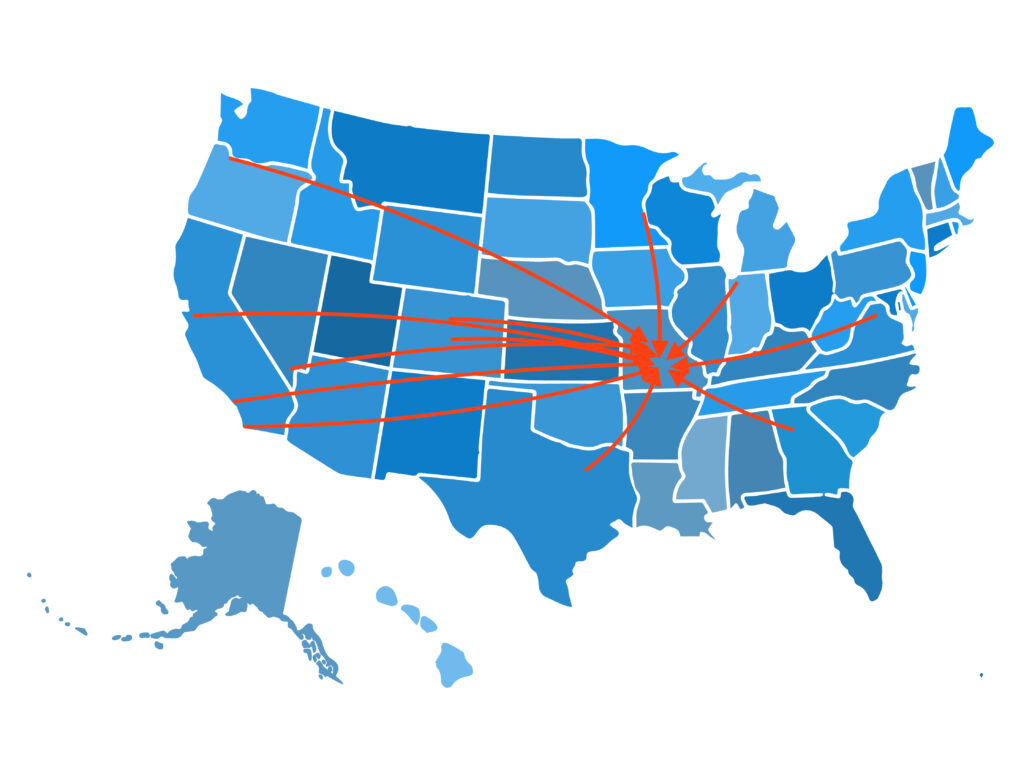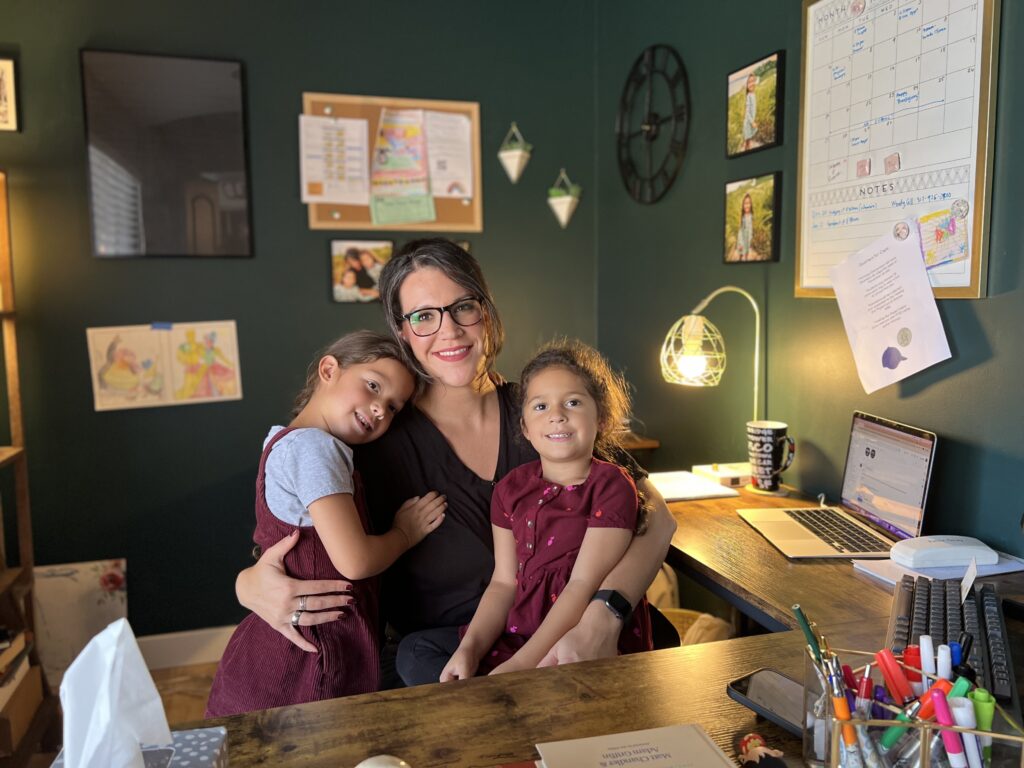The explosion of interest in Lake of the Ozarks has brought new residents from far-flung places. The remote-work trend is making it possible.

Photo by Lake Shots Photography
by Kate Robbins and Nathan Bechtold
The Covid-19 epidemic and the real estate boom that followed have expanded Lake of the Ozarks’ national profile, bringing a whole new crowd to the Lake-area. This new crop of Lake of the Ozark-ians are skewing younger, and coming from further away.
With crystal waters, beautiful shoreline and plenty of fun activities, the Lake of the Ozarks has historically been a tourist destination. But with exposure from the Netflix show Ozark and other national coverage of Lake of the Ozarks, the area has seen a boom in tourism and real estate. The Lake of the Ozarks Convention and Visitors Bureau (CVB) has been seeing a spike in tourists from places beyond just the Midwest. “During the pandemic we saw a huge shift in our visitor profile,” said Heather Brown, interim director of the CVB. “The Dallas market grew a lot. The Colorado market grew.”
The CVB is responding by directing their marketing to those areas and attending boat, sport and travel shows in Dallas. Brown said visitors from further away bring an interesting benefit: “They stay longer, they spend more money.”
Visitors often turn into home-buyers, and the Lake’s real estate professionals say they are seeing the same trend of far-flung folks coming to settle down here. Before, the vacation and second home real estate market was largely kept to people who lived within driving distance of the Lake.

More people are moving to the Lake of the Ozarks from the West. Adobe Stock
“It used to be an eight-hour circle, an eight-hour driving radius around the Lake. That’s where the majority came from,” said Jeff Krantz, of Krantz & Associates RE/MAX Lake of the Ozarks. “But now it’s anywhere, we are commonly seeing people from both coasts. The area has expanded for sure.” Bridgette Bigelow, mortgage loan officer with Central Bank of Lake of the Ozarks, agrees. Bigelow says she’s seen a steady flow of west-coasters coming to the Lake, undeterred by the past year’s spike in interest rates.
“It’s a it’s a very unique market. We’re still undervalued when you compare us to other lakes,” explained Krantz, who co-hosts an annual Real Estate Symposium at the Lake, where he and Jason Whittle (Jason Whittle All Pro Team, RE/MAX Lake of the Ozarks) reveal the year’s real estate trends and make predictions about what the next year will bring. Krantz says even the Lake’s premium waterfront real estate prices still look like a bargain to west-coasters considering a move to the Midwest. “Our taxes are cheap and there are things that just don’t happen in other lakes,” he said. “It’s a world-class fishing lake. It’s a world-class power boating lake. It’s world-class, surf and wakeboard lake.”
Calling the Lake area “unique” might even be an understatement. The region is essentially rural, but bears strange similarities to urban areas in some trends. A 2020 population report by the Lake of the Ozarks Regional Economic Development Council (LOREDC) stated the Lake area had 92,551 permanent residents. A LOREDC demographic study published around the same time notes, “The Region has a net positive flow of migrants since 2010 while most rural counties have experienced net out-migration.” So while Americans have been generally leaving rural areas for the past decade, the Lake is one of those rural areas that they’ve been flocking to. Migration could soon push the Lake area in a six-figure population for the first time ever, if it hasn’t already.
Unsurprisingly, LOREDC also found the Lake area has a negative birth rate — long a popular place for retirees, more people draw their last breath here than their first one. That figure, called the “crude birth rate,” is a bald comparison of births with deaths, and in the mid-2010s, Camden County had one of the lowest crude birth rates in the state of Missouri: ranked #110 out of 115. However, while the conclusions of that study were that Lake area leaders should focus on retaining the native population (read: give graduates a reason to stick around) in order to ensure demographic diversity and population resilience, a surprising trend has been bringing younger, non-retiree families into the Lake’s permanent resident picture: remote work.
Work From The Lake Home
The popularity and accessibility of remote work that accelerated during the Covid-19 lockdowns and has continued into today means more people are finding the Lake is where they can be, permanently. With a remote job, there’s no longer a need to drive back on Sunday to get to work on Monday. The Lake of the Ozarks offers beauty and recreation, but cities and suburbs offer career opportunities: hence the Lake’s anemic population of 20- and 30-somethings. But thanks to remote work, the Lake — long a place where young vacationers visit but whose permanent resident population was retiree-heavy — could be drawing younger people and families.

Gina working from home with her two daughters.
Gina Doing is chief of staff for a San Francisco-based company. She came to the Lake area in 2015, and working remotely means she can stay at Lake of the Ozarks and raise her family here. “You know, when I was pregnant with my first daughter, I was like, ‘There’s just got to be a way that I can be at home building my career, while also being the mom that I want to be,’” Doing said. The ability to work-from-Lake meant she wasn’t tied-down to one location… it even meant she could visit family back west without major interruptions to her work schedule. Especially before the girls were in school, Doing said, “We would travel a lot… being able to have that flexibility in my role where I wasn’t tied to going into an office. That’s great.”

Gina working from home with her two daughters.
Doing’s home, tucked into a quiet Lake area neighborhood, is set up so she can work and her girls — who are home for school on Mondays — can sit, working busily, at little desks facing hers. “The virtual world has really opened my eyes to how how possible that really is for not just me but for everybody,” she said.
Even second-homeowners who aren’t here full-time (yet) are enjoying the liberation that comes from remote work. “We’ve also noticed that some of our second homeowners have shifted and they’re staying for longer periods of time. They used to be weekenders, and now they’re here half the time because of the movement to work from home,” Whittle said.
Missing Housing
However, despite the availability of remote work, access to affordable housing remains an obstacle for remote-working people who would love to move to the Lake of the Ozarks. It’s also an issue facing many full-time working residents at Lake of the Ozarks, from service workers to hospital employees.
“Housing is definitely an obstacle,” said Jeana Wood, president of Lake of the Ozarks Regional Economic Development Council and Osage Beach City Administrator. “You need housing that will house all the different diversities of jobs you have in your area, and at the Lake we do have a lot of hospitality jobs but we also have professional jobs too. You need to have housing that should hit the lower end… all the way to the higher end.”

A rendering of the Preserve at Sycamore Creek, a new housing complex planned for Osage Beach.
Developers are looking for opportunities to meet that need. In 2022, Tegethoff Development announced plans to construct a new, $63 million apartment complex on Nichols Road in Osage Beach. They’re not exactly high-end luxury apartments, but they’re certainly not spartan: a spacious layout with pool and green spaces/common areas will accompany one-, two- and three-bedroom rental apartments with rent at $900, $1,400 and $2,000 per month. The new complex will bring 268 new apartments to the Lake, and it’s likely to be one of many, as other developers have begun working with Lake area elected officials on more projects.
The past few years changed the Lake forever. Countless people discovered Lake of the Ozarks for the first time, thanks to national media and Netflix. And the disruption of 2020 and 2021 was a windfall for the Lake, which offered a place to live, work, and play, plus four seasons and unforgettable sunsets.
As Krantz puts it, “People are happy to be here.”
